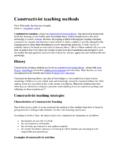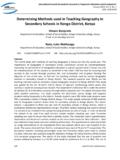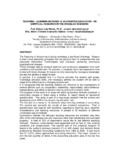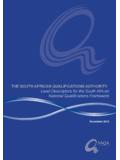Transcription of Learner-centered teaching methods - Fulbright …
1 Tarja Mykr . Learner-centered teaching methods A Toolkit for Secondary Education Teachers Indiana University Bloomington December 2015. Tarja Mykr . Education is not the filling of a pail, but the lightning of a fire . - William Butler Yeats Copyright 2015 by Tarja Mykr . 2. Tarja Mykr . CONTENTS. FOREWORDS .. 5. 1 INTRODUCTION: WHY DO WE NEED Learner-centered . teaching methods ? .. 7. 2 LEARNER MOTIVATION AND ENGAGEMENT .. 11. Amotivation .. 12. Extrinsic Motivation .. 13. Intrinsic 13. Learner 14. 3 SELF-EFFICACY AND EFFICACY 16. Differentiating Self-efficacy from Self-esteem .. 16. Efficacy Beliefs .. 16. Efficacy Believes and Outcome Expectancies.
2 17. 4 LEARNING .. 19. Different Theories of Learning .. 20. Learning as a 21. 5 teaching methods .. 23. teaching methods as a Tool to Strengthen Motivation and Self- efficacy .. 24. Level of Activation .. 24. 6 Learner-centered teaching methods .. 26. Gaining Attention .. 28. Have You Ever? .. 28. Forming Lines .. 29. Informing the Learner of the Objective .. 30. Knows Need to Know .. 30. Scavanger Hunt .. 31. Stimulating Recall or Prior Learning .. 32. Mind Mapping .. 32. Use of Videos in Flipped Classroom .. 34. Presenting the Stimulus .. 36. Jigsaw .. 36. Learning Stations .. 38. Providing Learner Guidance and Eliciting Performance.
3 40. Demonstration and Visualization .. 40. Muddiest Point Paper .. 42. 3. Tarja Mykr . Providing 43. Critical Friends .. 43. Bingo Review .. 45. Assessing Performance, Enhancing Retention and Transfer .. 47. Brainstorming .. 47. Gallery 49. 7 SHARING teaching methods .. 50. Sharing as a Part of Professional Competence .. 50. A template for Describing and Sharing teaching methods .. 51. Share Fair Workshop for Sharing teaching methods .. 53. 8 CONCLUSIONS .. 55. REFERENCES .. 57. 4. Tarja Mykr . FOREWORDS. This report is the final product of my inquiry project in Fulbright Distinguished Awards in teaching Program in Indiana University Bloomington, from August to December 2015.
4 The main purpose of my project was to discover which learner- centered teaching methods used by the secondary education teachers have proved successful in enhancing learner motivation and engagement. It is expected that these Learner-centered teaching methods also might help students with spe- cial needs and may help to decrease the number of students who drop out of ed- ucation. The report is based on my experiences of the educational system. I visited 10. different high schools and elementary schools, observed lessons in those schools, interviewed teachers and had conversations with students. I did a survey for stu- dents at a local high school and asked their experiences of their best lessons and the ways they would like to learn at school.
5 I also audited two courses at Indiana University Bloomington and attended ASCD Conference on Educational Leader- ship in San Diego. I studied all these experiences in the viewpoint of literature of motivation, self-efficacy, learning and teaching methods . As a result, I chose fourteen Learner-centered teaching methods for different phases of the learning process and described them with instructions on how to use these methods in a classroom. A template, which can be easily used for de- scribing and sharing teaching methods , is provided in this report. A protocol of a workshop for sharing teaching methods in a school, is also provided in this mate- rial.
6 My hope is that this report will give teachers new ideas of different learner-cen- tered teaching methods that can be used in different phases of learning. Another 5. Tarja Mykr . purpose of this report is to encourage teachers to describe teaching methods they use, to share these methods among other teachers in their schools and continue to try out new methods in their classrooms. Sharing, co-creation, and putting new ideas into practice is a part of teachers professional development. Without teach- ers development activities, it is not possible for a school to develop as a commu- nity. I make this report freely available to any teachers, principals and curriculum de- velopers.
7 It can be downloaded from website A template for describing and sharing teaching methods can also be downloaded from this website. I want to thank Dr. Bonk from Indiana University Bloomington and teacher Adam Price from Bloomington High School North for the help and advice they gave me during my project. I also want to thank IIE, CIEDR, various Fulbright teacher col- leagues and all the other teachers and people I met during my stay in the These four months I spent in the made my long-term dream come true. I ad- dress the biggest thank to my loved ones, my husband Jussi and son Matti who stayed at home in Finland during my visit to the Without them all is nothing.
8 Bloomington, Indiana, USA. December 9th, 2015. Tarja Mykr . 6. Tarja Mykr . 1 INTRODUCTION: WHY DO WE NEED Learner-centered TEACH- ING methods ? Many researches and educators (Driscoll 1994; Bandura 1997; Marzano 2007) ar- gue that learning must be situated in the context of meaningful activity for knowledge to be used in similar situations later in life. Teachers can help students learn how to learn, nurture their willingness to solve problems, and build their capacity for hard work and persistence. Teachers can also help students to develop perseverance and motivation by supporting them in their efforts to meet expec- tations and in showing greater degrees of commitment.
9 They can do this by en- couraging students to regard mistakes and setbacks as learning opportunities. It is a basic generalization that learners must be actively engaged in the processing of information and that the teaching and learning process involves an interaction among the teacher, the students, and the content (Marzano 2007, p. 31). Students all over the world have been known to acquire inert knowledge, such as definitions and formulas that they do not really know how to apply meaningfully. For that to occur, learning must involve authentic activity (Driscoll 1993, p. 162). Elements such as a well-articulated curriculum and a safe and orderly environment constitute an effective school and learning environment.
10 One element that sur- faces as the single most influential component is the individual teachers within that school. The influence of an effective teacher has on learner achievement is relatively independent of anything else that occurs in the school. Many studies point out that the more teachers have pedagogical competence, the greater the achievement of the students is (Marzano 2007, pp. 1-2). Today s learners are more connected to technology than previous generations. Millennials (birth years ranging from the early 1980s to the early 2000s) are a tech- nologically connected, diverse, and tolerant generation. They believe that their 7.







